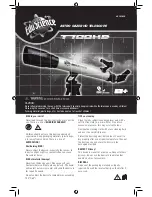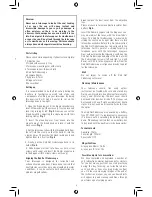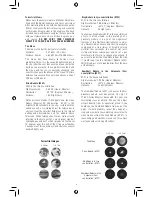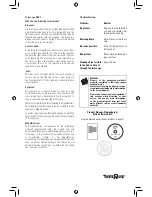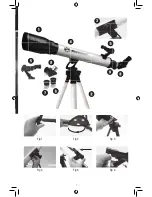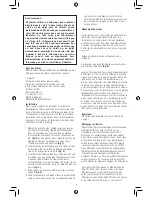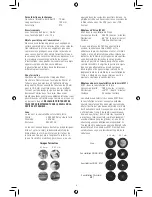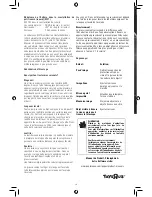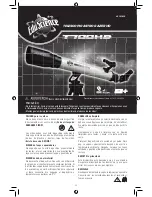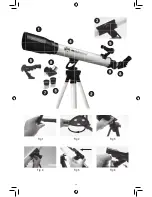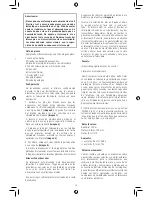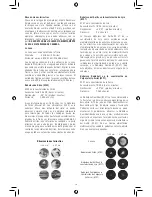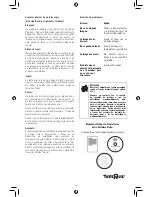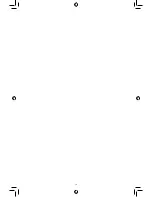
2
3
Parts listing
Please check while unpacking, if all parts are complete:
1 Objective lens
2 Tripod with accessory tray
3 Telescope mounting arm with clamp
4 Telescope tube with dew shield
5 Red Dot Finderscope
6 Eyepiece 26mm
7 Eyepiece 9.7mm
8 Diagonal mirror
9 Focus wheel
Setting up
It is recommended to do the fi rst set-up during the
daytime to familiarise yourself with steps and
components of setting up your telescope. By doing
this exercise it will make it easier to set up the
telescope even in low light.
1. Open the tripod legs until the tripod spreaders are
level. Afterwards, put the accessory tray in place and
lock it by turning by 60°
Fig 2
. Now you can set the
tripod height by adjusting the single legs with their
locking clamps
Fig 1
.
2. Insert the mounting arm from above into the
mount hole at the tripod head and lock it with the
black screw
Fig 3
.
3. Set the telescope tube with the threaded bolts from
the left into the clamp so that the bolts fi t into the
clamp’s holes. Then screw the black locking nuts and
tighten them to a fi rm feel
Fig 4
.
4. Finally, put the Red Dot Finderscope back in its
holder
Fig 5
.
5. Slide diagonal mirror into Focuser (turn silver
screws until snug) and insert the 26mm eyepeice in
to the diagonal (turn silver screws until snug).
Aligning the Red Dot Finderscope
Your telescope is designed for terrestrial and
astronomical observations. Please keep in mind that
heat turbulences in the air are also magnifi ed. In warm
conditions, it can be useful to limit observations to
medium magnifi cations.
First, remove the dust cover from the objective
lens.
First, remove the dust cover from the objective
First, remove the dust cover from the objective
Please make sure to remove plastic insulator from
battery
Fig 6
.
Insert the 26mm Eyepiece into the diagonal, you
may now adjust the focus with the draw tube’s
wheel. The Red Dot Finderscope is activated by
sliding the switch on its right side; there are two
intensities available. Before the fi rst observation,
the Red Dot Finderscope has to be aligned to the
telescope. For this, point at a striking target (e.g.
telephone pole) with the telescope’s eyepiece.
Now, without moving the telescope, switch on the
Red Dot Finderscope and adjust the red dot with
the 2 adjustment screws (left and right - up and
down) until it fi ts to the eyepiece’s view. Now the
Red Dot Finderscope is aligned and ready to point
for the telescope.
Hint:
Do not forget to switch off the Red Dot
Finderscope after use!
Cleaning / Maintenance
Your telescope should, like every optical
instrument, be treated with care and stored dry.
Doing so will maintain its optical performance for
many years. After using, the dust cover should
be closed after dew has dried off. The lenses can
be cleaned with a soft cloth available from photo
stores. Do not use harsh cleaning fl uids to clean
the optics.
The Red Dot Finderscope is powered by a battery
type CR-2032 (3V); if a replacement is necessary,
it is drawn out by spreading the holding spring
down. Please keep in mind that a new battery has
to be placed with the positive (+) side downwards!
Technical data
Aperture: 70mm
Focal length: 700mm
Focal ratio: f/10
Magnifi cations
w/ eyepiece 26mm: 26.9x
w/ eyepiece 9.7mm: 72x
Possible objects for observation:
We have compiled and explained a number of
very interesting celestial bodies and star clusters
for you but we suggest that you start practicing
during the day focusing on terrestrial objects
such as birds or trees at varying distances from
you. On the accompanying images at the end of
the instruction manual, you can see how objects
will appear in good viewing conditions through
your telescope at varying powers.
Warning:
Never use a telescope to look at the sun! Looking
at or near the sun will cause instant and
irreversible damage to your eye. Eye damage is
often painless, so there is no warning to the
observer that damage has occurred until it is too
late. Do not point the telescope or its viewfi nder at
or near the sun. Do not look through the telescope
or its viewfi nder as it is moving. Children should
always have adult supervision while observing.
Содержание T700HD
Страница 2: ...2 Fig 1 Fig 4 Fig 2 Fig 5 Fig 3 Fig 6 8 8 7 6 5 5 4 3 2 1 9 8 8 8 7 7 6 6 5 5 4 2 1 9 ...
Страница 7: ...7 8 8 7 6 5 5 4 3 2 1 9 Fig 1 Fig 4 Fig 2 Fig 5 Fig 3 Fig 6 8 8 8 7 7 6 6 5 5 4 2 1 9 ...
Страница 12: ...12 Fig 1 Fig 4 Fig 2 Fig 5 Fig 3 Fig 6 8 8 7 6 5 5 4 3 2 1 9 8 8 8 7 7 6 6 5 5 4 2 1 9 ...
Страница 16: ...16 ...

